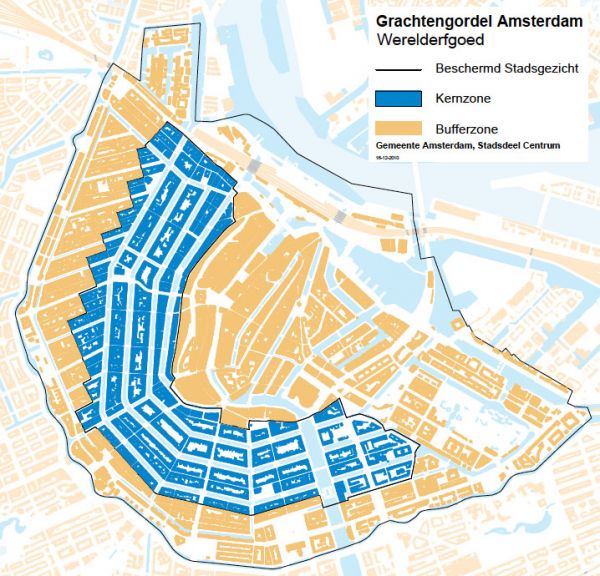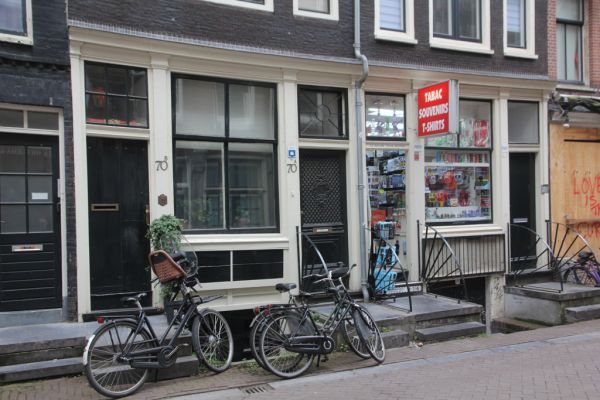UNESCO Werelderfgoed

Amsterdam heeft één van de belangrijkste en gaafste historische stadskernen van de wereld. Dit feit heeft internationale erkenning gekregen in de aanwijzing als UNESCO Werelderfgoed in 2010. Het is geen toeval dat de grachtengordel het kerngebied vormt van het Werelderfgoed. Dit is het best bewaarde gedeelte van de historische binnenstad. Bovendien is de 17de-eeuwse stadsuitbreiding waarin de grachtengordel tot stand kwam, vanuit internationaal gezichtspunt gezien van groter belang dan het middeleeuwse stadshart.
Overigens heeft de aanwijzing als binnenstad voor de gehele binnenstad gevolgen. De UNESCO vereist namelijk dat rondom het Werelderfgoed een bufferzone wordt bepaald waarin hetzelfde beschermingsregiem geldt. Het kerngebied van het Werelderfgoed betreft de 17de-eeuwse grachtengordel, terwijl de rest van de Amsterdamse binnenstad als bufferzone fungeert.
De beschrijving van het UNESCO Werelderfgoed, Seventeenth-century canal ring area of Amsterdam inside the Singelgracht, luidt: "The historic urban ensemble of the canal district of Amsterdam was a project for a new 'port city' built at the end of the 16th and beginning of the 17th centuries. It comprises a network of canals to the west and south of the historic old town and the medieval port that encircled the old town and was accompanied by the repositioning inland of the city’s fortified boundaries, the Singelgracht. This was a long-term programme that involved extending the city by draining the swampland, using a system of canals in concentric arcs and filling in the intermediate spaces. These spaces allowed the development of a homogeneous urban ensemble including gabled houses and numerous monuments. This urban extension was the largest and most homogeneous of its time. It was a model of large-scale town planning, and served as a reference throughout the world until the 19th century."
Op advies van ICOMOS - adviesorgaan van de UNESCO - heeft het UNESCO Werelderfgoedcomité enkele aanbevelingen aan de 'siteholder' gedaan. De UNESCO vraagt aan de gemeente Amsterdam:
- Pursuing the application of measures to eradicate aggressive advertising hoardings and video screens on scaffolding and work-site fences inside the property and submit a detailed report on the situation of advertising displays within the property for examination at the 34th session of the World Heritage Committee (2011);
- Giving thought to a charter of good conduct between the city and the private commercial sector, defining what is and is not allowed with regard to how buildings are treated, shop fronts, signage and lighting, the occupation of public space, urban furniture, terraces, etc.;
- Making sure that when the Amsterdam Central Borough examines building permits, conservation objectives remain paramount;
- Ensuring effective control over projects for tall buildings within the agglomeration to monitor their architectural quality and ensure that they are in harmony with the visual expression of the value of the property;
- Keeping the World Heritage Committee informed of any development project concerning the property, its buffer zone, and surroundings in conformity with paragraph 172 of the Operational Guidelines for the Implementation of the World Heritage Convention.
Het Werelderfgoed wordt jaarlijks gemonitored en geëvalueerd. De aanwijzing is een internationale erkenning voor de bijzondere waarde van de Amsterdamse binnenstad, maar ook voor de verdiensten van vele particuliere eigenaren en instellingen die de binnenstad hebben weten te behouden, in de jaren zeventig nog tegen het gemeentebeleid in.
Laatste wijziging: augustus 2023


